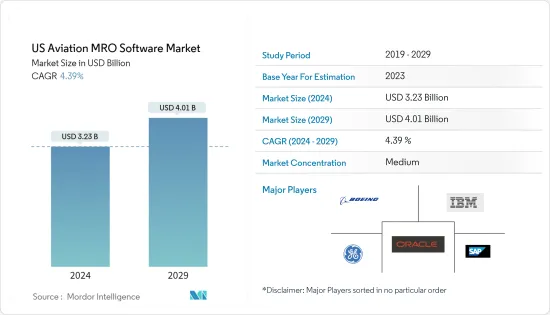PUBLISHER: Mordor Intelligence | PRODUCT CODE: 1521642

PUBLISHER: Mordor Intelligence | PRODUCT CODE: 1521642
US Aviation MRO Software - Market Share Analysis, Industry Trends & Statistics, Growth Forecasts (2024 - 2029)
The US Aviation MRO Software Market size is estimated at USD 3.23 billion in 2024, and is expected to reach USD 4.01 billion by 2029, growing at a CAGR of 4.39% during the forecast period (2024-2029).

The US aircraft MRO software market represents an evolving market within the broader aviation MRO industry. It is characterized by an ecosystem of stakeholders, OEMs, IT companies, software developers, airlines, MRO service providers, and regulatory bodies. With a robust aerospace sector, the US serves as a key hub for aircraft MRO activities, covering various services and solutions at different stages to ensure the safety, reliability, and efficiency of commercial, general aviation, and military aircraft fleets. The market is influenced by technological advancements, rising aircraft fleets, rising investments, and regulatory compliance requirements.
Technological advancements are the primary factor driving innovation and transformation within the aircraft MRO software market. Adopting cloud computing, IoT, big data analytics, and artificial intelligence is revolutionizing MRO operations, enabling MRO service providers to optimize maintenance processes, improve decision-making, and enhance overall efficiency and aircraft safety. Predictive maintenance is a key trend, leveraging real-time data and predictive analytics to anticipate equipment failures and proactively schedule maintenance activities, reducing downtime and minimizing costs for carriers, MRO service providers, and OEMs.
However, the market has its challenges. Regulatory compliance requirements and fuel prices challenge market stability, growth, and investment. The need for a more skilled workforce in the US presents a persistent challenge, limiting the availability of qualified maintenance professionals for aircraft maintenance operations.
US Aviation MRO Software Market Trends
The On-premise Segment is Expected to Dominate the Market During the Forecast Period
The on-premise solutions offer numerous advantages, such as excellent availability/reliability, enhanced speed, and security. These systems work with local servers; thus, the speed can be well-managed and controlled. Furthermore, the solutions have low operating costs as they require a one-time purchasing fee and maximum control over other MRO solutions.
The US has the largest commercial aircraft fleet, which implies a growing number of aging aircraft fleets. The presence of several MRO facilities and increasing expenditure on aircraft upgrade programs create demand for advanced MRO software, which propels market growth. For instance, in March 2023, AAR Corporation, a provider of aviation services to commercial and government operators, OEMs, and MROs, acquired Trax USA Corp., an independent provider of aircraft MRO and fleet management software. The acquisition will accelerate AAR's strategy to offer digital solutions to aftermarket end users.
Such developments and the introduction of advanced on-premises MRO software solutions that provide enhanced security, higher availability, and reliability are expected to drive the market's growth during the forecast period.
The Airlines Segment is Projected to Record the Highest Growth Rate in the Market
The US is one of the largest markets for aviation MRO software, owing to high demand for air travel, large fleet size, and significant investments in aircraft modernization programs from the US. Increasing air traffic, rising expenditure on aviation infrastructure, and aircraft modernization programs from airlines in the US drive the market growth.
Some of the largest airlines in the US are American Airlines, United Airlines, Delta Airlines, Southwest Airlines, Alaska Airlines, and others. These airlines adopt advanced MRO software to improve the life of aircraft. For instance, in February 2024, American Airlines announced plans to hire hundreds of new employees for its two largest maintenance bases in the US. In late 2023, the airline received funds of USD 22 million from the state of Oklahoma's Business Expansion Incentive Program to grow and upgrade its MRO facility in Tulsa. As a part of the program, the carrier plans to add more than 300 new technical operations employees, which include airframe and powerplant mechanics, machinists, engineers, welders, and maintenance planners.
Hence, the growing adoption of advanced MRO software for aircraft and rising investments from airlines for aircraft modernization programs to extend the life of aging aircraft are expected to boost the market's growth during the forecast period.
US Aviation MRO Software Industry Overview
The market is semi-consolidated, with several players holding significant shares in the market. The Boeing Company, IBM Corporation, Oracle Corporation, GE Aviation, and SAP SE are the leading market players.
The aviation industry is witnessing a significant transformation with increasing investments in research and development, leading to the advent of advanced aircraft maintenance, repair, and overhaul (MRO) software. Furthermore, MRO companies are expanding their operations geographically and strategically partnering with local service providers to enhance their service offerings and global footprint. These collaborations will foster a more interconnected and efficient global MRO network. For instance, in March 2023, AAR Corporation, a provider of aviation services to commercial and government operators, OEMs, and MROs, acquired Trax USA Corp., an independent provider of aircraft MRO and fleet management software.
Additional Benefits:
- The market estimate (ME) sheet in Excel format
- 3 months of analyst support
TABLE OF CONTENTS
1 INTRODUCTION
- 1.1 Study Assumptions
- 1.2 Scope of the Study
2 RESEARCH METHODOLOGY
3 EXECUTIVE SUMMARY
4 MARKET DYNAMICS
- 4.1 Market Overview
- 4.2 Market Drivers
- 4.3 Market Restraints
- 4.4 Porter's Five Forces Analysis
- 4.4.1 Bargaining Power of Buyers/Consumers
- 4.4.2 Bargaining Power of Suppliers
- 4.4.3 Threat of New Entrants
- 4.4.4 Threat of Substitute Products
- 4.4.5 Intensity of Competitive Rivalry
5 MARKET SEGMENTATION
- 5.1 Deployment
- 5.1.1 Cloud-based
- 5.1.2 On-premises
- 5.2 End Users
- 5.2.1 Airlines
- 5.2.2 MROs
- 5.2.3 OEMs
6 COMPETITIVE LANDSCAPE
- 6.1 Vendor Market Share
- 6.2 Company Profiles
- 6.2.1 IBM Corporation
- 6.2.2 Oracle Corporation
- 6.2.3 The Boeing Company
- 6.2.4 Jet Support Services Inc.
- 6.2.5 SAP SE
- 6.2.6 Flatrion Solutions Inc.
- 6.2.7 GE Aviation
- 6.2.8 APT Inc.
- 6.2.9 Camp Systems International Inc.
- 6.2.10 Honeywell Automation Ltd




